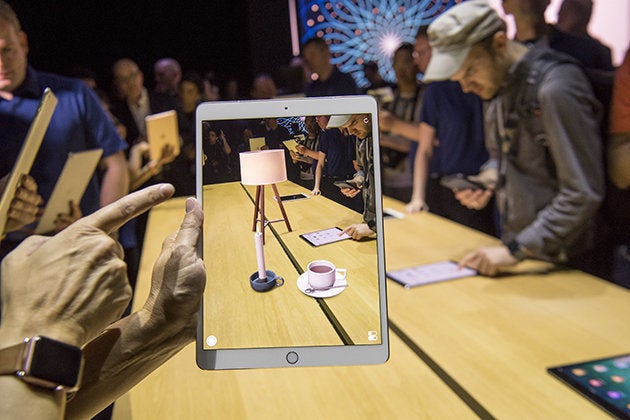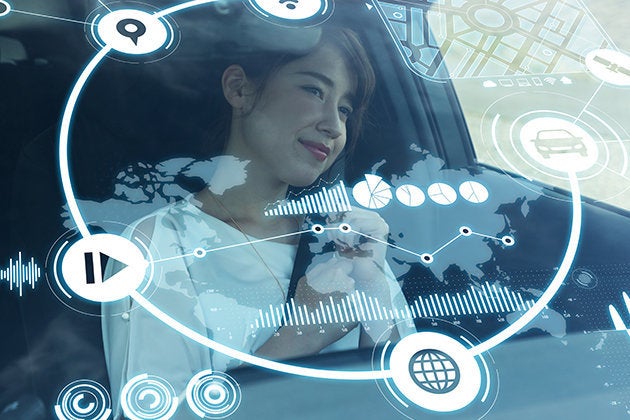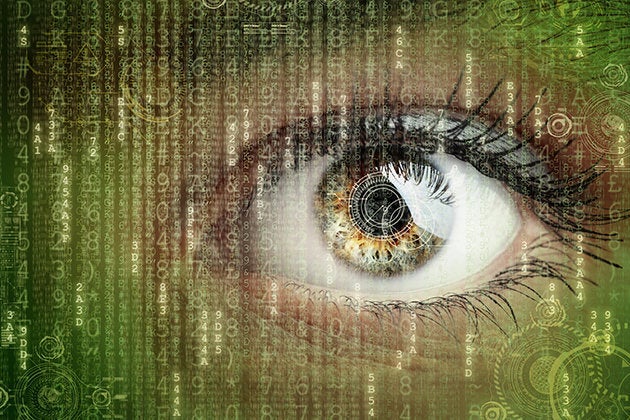It is odd to think the Internet has only been with us for the past 25 years, or that the ubiquitous smartphone is barely even 10 years old. Technology is evolving at such a rate that simply keeping up with the latest innovations can seem like a full-time job. Here are some speculations on where five pieces of tech you use every day might be heading.
PHONE

Getty
It’s hard to believe the smartphone has only been with us for a decade, such is the seismic shift it has created in our daily lives. But where does the smart phone go from here?
The consensus seems to be that the camera will take centre stage, using 3D imaging to further develop innovative functions such as face recognition (as seen on the new iPhone) and augmented reality (AR), which uses data to digitally manipulate the physical world when you look through a screen.
Let’s say you’re buying a sofa and want to get an idea of how it will appear in your living room – simply look through your phone to see it virtually materialise in that space.
In order for newer, more powerful apps driven by AR to function successfully, the phone’s battery life will have to change too.
Wireless charging will be necessary and be realised by what is called ‘inductive charging’. This means your phone simply takes energy from charging ports nearby and thus never runs out of gas. Ultimately, AR might mean the phone itself disappears and wearable tech takes over, like headsets, glasses or even contact lenses. Terminator vision at last.
The consensus seems to be that the camera will take centre stage, using 3D imaging to further develop innovative functions such as face recognition (as seen on the new iPhone) and augmented reality (AR), which uses data to digitally manipulate the physical world when you look through a screen.
Let’s say you’re buying a sofa and want to get an idea of how it will appear in your living room – simply look through your phone to see it virtually materialise in that space.
In order for newer, more powerful apps driven by AR to function successfully, the phone’s battery life will have to change too.
Wireless charging will be necessary and be realised by what is called ‘inductive charging’. This means your phone simply takes energy from charging ports nearby and thus never runs out of gas. Ultimately, AR might mean the phone itself disappears and wearable tech takes over, like headsets, glasses or even contact lenses. Terminator vision at last.
CAR

Getty
The era of the electric car under way, and within a generation it will be the norm on the roads.
Beyond EVs, the next great leap will be self-driving cars. While the technology is still being tweaked, no one in the industry doubts this will happen, and what it means is a fundamental change in the way we use cars.
We will still have the option to drive, but car interiors will come to resemble rooms in the domestic sense, be it a living room, an office, or maybe even a mobile disco...
The car’s windscreen and windows could be used to project films, TV channels, your computer desktop, and even utilise AR to provide information about passing landmarks.
Self-driving cars also open up the possibility of a completely synchronised road system, where vehicles are continuously mapped via satellite and an algorithm prevents unnecessary traffic build-ups by automatically sending cars along alternative routes.
We might also have cars that generate power as they drive, thanks to roads that respond to kinetic energy. Piezoelectric crystals embedded in floors, walkways and even shoes, already provide small amounts of electric charge when pressed. If this were scaled up and put under busy motorways as our cars move over them, they would generate some of the power needed to move the car in the first place.
Beyond EVs, the next great leap will be self-driving cars. While the technology is still being tweaked, no one in the industry doubts this will happen, and what it means is a fundamental change in the way we use cars.
We will still have the option to drive, but car interiors will come to resemble rooms in the domestic sense, be it a living room, an office, or maybe even a mobile disco...
The car’s windscreen and windows could be used to project films, TV channels, your computer desktop, and even utilise AR to provide information about passing landmarks.
Self-driving cars also open up the possibility of a completely synchronised road system, where vehicles are continuously mapped via satellite and an algorithm prevents unnecessary traffic build-ups by automatically sending cars along alternative routes.
We might also have cars that generate power as they drive, thanks to roads that respond to kinetic energy. Piezoelectric crystals embedded in floors, walkways and even shoes, already provide small amounts of electric charge when pressed. If this were scaled up and put under busy motorways as our cars move over them, they would generate some of the power needed to move the car in the first place.
COMPUTER

Getty
The PC has seen a decline in popularity in recent years, essentially because devices like phones and tablets have encroached on its territory. For this reason the lines may continue to blur around what exactly constitutes a computer.
Certainly they should get lighter and have more flexibility than the weighty behemoths that still dominate. One possibility is that the PC will become little more than an access key you plug into terminals anywhere, and which then configure to your entire desktop.
Indeed, all of the technical innovations happening now are bound to figure in some way, whether it’s voice/visual recognition, augmented reality, or even the latest advances in AI, with your computer talking to you and even making suggestions dependent on your actions or mood.
Processing speed and memory remain the PC’s main advantage and these will continue to increase exponentially to the point, say some scientists, where a ‘quantum class’ of computers will develop.
“These technologies,” says Winfried Hensinger of the University of Sussex, “will in a few milliseconds crack problems which would take the fastest conventional computer years.”
One other development from the realms of science fiction (and one that would make personal computing extremely personal) would be a means to directly connect the PC to the human brain.
“This would allow us to integrate 3D nano electronics with our neural networks,” says Charles M Lieber, Professor of Chemistry at Harvard University. Essentially, you and your PC will one day merge to make a cyborg. Let’s just hope fixing our personal problems might be as easy as switching us off and on again.
Certainly they should get lighter and have more flexibility than the weighty behemoths that still dominate. One possibility is that the PC will become little more than an access key you plug into terminals anywhere, and which then configure to your entire desktop.
Indeed, all of the technical innovations happening now are bound to figure in some way, whether it’s voice/visual recognition, augmented reality, or even the latest advances in AI, with your computer talking to you and even making suggestions dependent on your actions or mood.
Processing speed and memory remain the PC’s main advantage and these will continue to increase exponentially to the point, say some scientists, where a ‘quantum class’ of computers will develop.
“These technologies,” says Winfried Hensinger of the University of Sussex, “will in a few milliseconds crack problems which would take the fastest conventional computer years.”
One other development from the realms of science fiction (and one that would make personal computing extremely personal) would be a means to directly connect the PC to the human brain.
“This would allow us to integrate 3D nano electronics with our neural networks,” says Charles M Lieber, Professor of Chemistry at Harvard University. Essentially, you and your PC will one day merge to make a cyborg. Let’s just hope fixing our personal problems might be as easy as switching us off and on again.
Advertisement
INTERNET

Getty
The Internet may seem normal to us now, but its integration in our lives is only just beginning. For example, think about how in some areas you still struggle to get a Wi-Fi signal; in the future the degree of coverage and connectivity will mean constant, streamed access.
What’s more, the Internet will be found in all kinds of domestic objects, thanks to Internet of Things technology (IoT). Fridges will reorder food, your alarm clock will let your coffee machine know when to prepare that morning cappuccino, and washing machines will automatically sort clothes and choose the optimum time to put on a wash (i.e. when electricity is cheapest).
The Internet will become the glue that holds the smart city together, for example enabling energy transfers between public transport and buildings depending on usage, or providing (self-driving) fire and ambulance services with traffic-free routes through busy conurbations.
The downside? Issues with privacy will become even more urgent when our movements and habits are tracked by the internet 24/7.
What’s more, the Internet will be found in all kinds of domestic objects, thanks to Internet of Things technology (IoT). Fridges will reorder food, your alarm clock will let your coffee machine know when to prepare that morning cappuccino, and washing machines will automatically sort clothes and choose the optimum time to put on a wash (i.e. when electricity is cheapest).
The Internet will become the glue that holds the smart city together, for example enabling energy transfers between public transport and buildings depending on usage, or providing (self-driving) fire and ambulance services with traffic-free routes through busy conurbations.
The downside? Issues with privacy will become even more urgent when our movements and habits are tracked by the internet 24/7.
TELEVISION

Getty
Ah, the humble TV. In today’s uber-hi-tech world, it almost feels like a fusty old relic. But even if we spend much of our time these days looking at screens in the palm of our hands, most of us still want to watch films on a screen big enough to properly immerse us in the action.
Ultra-thin TVs like LG’s ‘wallpaper’ OLED TV already exist, some so lightweight they can be held in place by wall magnets.
In the future, this kind of ‘go-anywhere’ foldable TV screen is set to become the norm, so you can roll it up, much like a poster, and unroll it at any destination.
It’s also likely the television becomes more about establishing an image on any surface, so your future TV may in fact come to be replaced by a mini-projector, perhaps one that works in some form of 3D without the need for the viewer donning glasses.
Ultra-thin TVs like LG’s ‘wallpaper’ OLED TV already exist, some so lightweight they can be held in place by wall magnets.
In the future, this kind of ‘go-anywhere’ foldable TV screen is set to become the norm, so you can roll it up, much like a poster, and unroll it at any destination.
It’s also likely the television becomes more about establishing an image on any surface, so your future TV may in fact come to be replaced by a mini-projector, perhaps one that works in some form of 3D without the need for the viewer donning glasses.